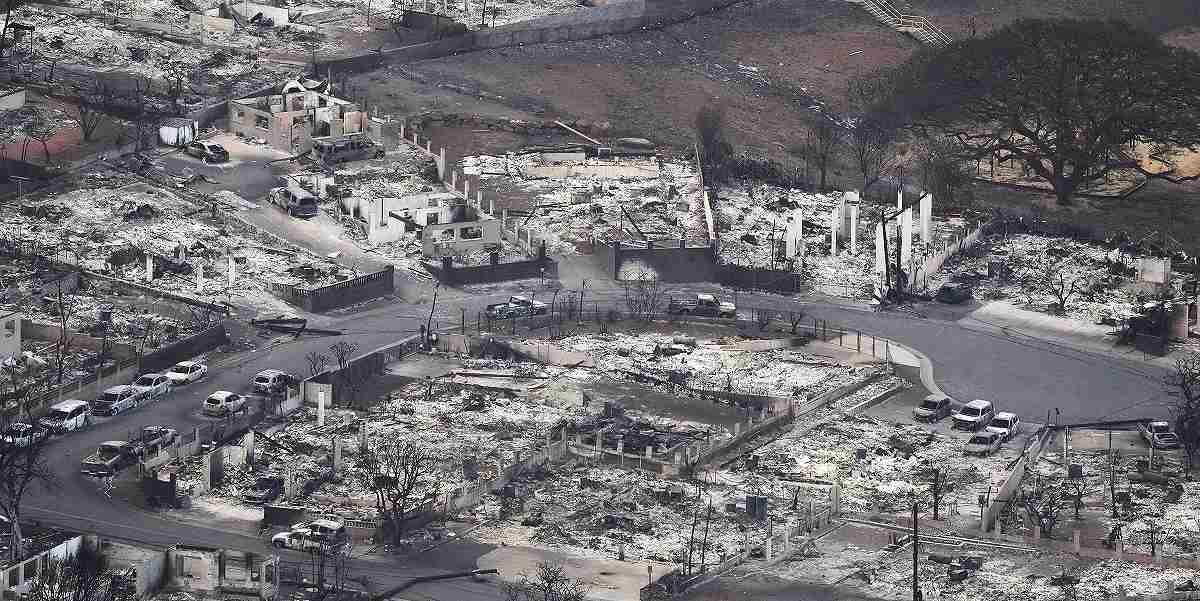
Wildfire wreckage is shown Thursday, Aug. 10, 2023, in Lahaina, Hawaii.
16:54 JST, August 11, 2023
Raging, wind-whipped wildfires this week have killed at least 36 people in Hawaii and destroyed much of the Maui town of Lahaina. While months of drought set the stage for the fires, it was the confluence of two weather systems – high pressure to the north and Category 4 Hurricane Dora to the south – that incited the winds that spread the blazes at devastating speeds.
Wildfires are relatively common on the Hawaiian islands. About 0.5 percent of Hawaii’s land area burns each year, “equal to or greater than the proportion burned of any other U.S. state,” according to the Hawaii Wildfire Management Organization. This week’s firestorm, however, has been uncommon in its ferocity, destroying hundreds of buildings, forcing mass evacuations and cutting power to as many as about 13,000 customers.
A bit of meteorology explains what sparked the violent winds behind Hawaii’s fast-moving firestorm.
Months of drought set the stage for the fires by drying out vegetation, which has become more flammable in recent decades because of the spread of nonnative grasses. But it’s been unusually strong winds that have caused the fires to spread out of control so quickly. Gusts as high as 67 mph were reported in Maui County, and up to 82 mph in Hawaii and Honolulu counties.
The gusty winds are the result of a large difference in pressure – more than 60 millibars – between high pressure to the north of the islands and low pressure associated with Dora passing to the south. Differences in atmospheric pressure create wind, and gusts become intense when the differences are steep over small distances.
While it’s not unusual for high pressure to set up north of Hawaii and to usher in strong east to west breezes, the added presence of Dora intensified the winds by increasing the pressure difference over the region.
The breezes sweeping over the islands were not only extremely gusty but also were unusually dry.
As the arid winds swept over the West Maui Mountains, they forced air to accelerate down the west side of the mountains. These are known as “downslope” winds, which compress and heat the air as they descend and dry it out even more. Such winds increase the risk of wildfires, and gusts can quickly fan flames.
“We’ve seen this time and time again: downslope wind storms are drivers of the highest impact fires,” tweeted Neil Lareau, a professor of meteorology and a wildfire expert at the University of Nevada at Reno.
These dry downslope winds have different names in different parts of the world. In Southern California, they’re called Santa Ana winds, which are a common culprit in many of the state’s worst wildfires. In Alaska, and along the Rocky Mountains, they are known as the Foehn or Chinook winds.
It’s not the first time that hurricane winds have aided the development of Hawaiian wildfires. In 2018, downslope winds from Hurricane Lane helped to initiate multiple fires on Maui and Oahu. Hurricane Lane passed much closer to Hawaii – about 150 miles to the south – which was close enough to trigger flooding and fires at the same time.
“With strong high pressure to the north of the state and Lane advancing from the south, sustained winds of around 30 mph and gusts in excess of 50 mph blew across western Maui. Driven by these winds, three wildfires rapidly charred 2,000 acres and destroyed 21 residential structures, causing over $4 million in reported damage,” the National Hurricane Center wrote in a report.
Because Dora passed much farther away, about 500 miles south of Hawaii, not all meteorologists agree on the extent of Dora’s role in fanning this week’s deadly flames. But the consensus is that the hurricane, which has traveled about 4,400 miles across the Pacific, played a role.
"News Services" POPULAR ARTICLE
-

American Playwright Jeremy O. Harris Arrested in Japan on Alleged Drug Smuggling
-

Japan’s Nikkei Stock Average as JGB Yields, Yen Rise on Rate-Hike Bets
-

Japan’s Nikkei Stock Average Licks Wounds after Selloff Sparked by BOJ Hike Bets (UPDATE 1)
-

Japanese Bond Yields Zoom, Stocks Slide as Rate Hike Looms
-

Japan’s Nikkei Stock Average Buoyed by Stable Yen; SoftBank’s Slide Caps Gains (UPDATE 1)
JN ACCESS RANKING
-

Keidanren Chairman Yoshinobu Tsutsui Visits Kashiwazaki-Kariwa Nuclear Power Plant; Inspects New Emergency Safety System
-

Imports of Rare Earths from China Facing Delays, May Be Caused by Deterioration of Japan-China Relations
-

University of Tokyo Professor Discusses Japanese Economic Security in Interview Ahead of Forum
-

Japan Pulls out of Vietnam Nuclear Project, Complicating Hanoi’s Power Plans
-

Govt Aims to Expand NISA Program Lineup, Abolish Age Restriction



















